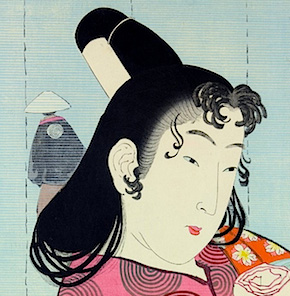About This Print
One of 118 prints in the series Dai Nippon Bussan Zue (Products of Greater Japan), issued in August 1877 to coincide with the opening of Japan’s first National Industrial Exposition (Naikoku Kangyō Hakurankai) held in Tokyo’s Ueno Park. Camellia tree oil (tsubaki) is extracted from the seed pods of the Camellia japonica and used as a hair conditioning treatment.
Izu Province (伊豆国 Izu-no kuni) was a province of Japan in the area of Shizuoka Prefecture. Izu bordered on Sagami and Suruga Provinces. Its abbreviated form name was Zushū (豆州). The mainland portion of Izu Province, comprising the Izu Peninsula is today the eastern portion of Shizuoka Prefecture and the Izu Islands are now part of Tokyo.1
1 Wikipedia http://en.wikipedia.org/wiki/Izu_ProvinceCamellia Oil - as described in an 1889 survey sponsored by the Prussian Government
Source: The Industries of Japan: Together with an Account of its Agriculture, Forestry, Arts and Commerce, Johannes Justus Rein, A. C. Armstrong & Son, 1889, p. 152.Tsubaki-no-abura, Sasank’wa-no-abura, Cha-no-abura. Under these names the thick oils from the nut-like seeds of the following plants are known in Japan, where they are used principally for the hair: Camellia japonica, L., Jap. Tsubaki, C. Sasanqua, Thunb., Jap. Sasank’wa, and C. theifera, Griffith, Jap. Cha. These contain 30-35% of oil.
Only those tea-nuts which are not needed for planting are used for making tea-seed-oil. But the two other kinds of camellia are grown specially for their oily seeds. Thus, for instance, in the coast-country of Sendi and Nambu on the Pacific Ocean, between latitude 38 and 40, camellias are planted either singly or in rows along the edge of many a field or roadside. They are regular trees, some of them having straight boles 4 to 6 m. high and 30 cm. in diameter. Their shapely dark green crowns stand out sharp against the fading foliage of most of the other growths, especially in autumn.

Camellia oil was a necessity for the well-coiffed geisha in 1790s Edo. In the shimada style "a simple but elegant coiffure... the side locks are stiffened with camellia nut oil (tsubaki abura) and pulled to the back. The hair is raised above the crown and gathered behind in a large loop that is secured at two or three points."
Scroll Inscription
Source: National Museum of Japanese History http://www.rekihaku.ac.jp/up-cgi/getdocrd.pl?tn=1536&ti=0&h=./history/w11288752628_28652&ch=2&p=param/nisikie/db_param&o=1501&k=50&l=&sf=0&so=Notes:
中判 横 錦絵 画工:歌川広重3 大鋸町四番地 版元:大倉孫兵衛 日本橋通一丁目十九番地 主題内容:産業・技術 物産絵 伊豆 新島 三宅島 人名その他:椿 椿油 臼
「当国新島三宅島其他七島中椿樹の多きこと本邦第一とす 山野に自生してその花尤も艶麗なり 花ちりて後実をむすぶ 土人これを採りて臼にて搗袋に入れて〆木にかけ油を搾る その色しろく澄清にして粘らず 洋州のホルト油に勝れり」
Multiple Editions (Variant Printings)
At least three variant printings (editions) were made of this series. Each variant printing uses a different colored cartouche containing the series' title, either red, green or rainbow-colored. Different colored borders were also used and variances in the use of colors and shading are present in the three editions.
Print Details
| IHL Catalog | #365 |
| Title or Description | Making Camellia Oil in Izu Province 伊豆國 椿樹油取圖 |
| Series | Dai Nippon Bussan Zue 大日本物産図会 (Products of Greater Japan) |
| Artist | Utagawa Hiroshige III (1842–1894) |
| Signature | no signature seen in the margin of this print |
| Seal | none |
| Publication Date | 1877 (Meiji 10) |
| Publisher | Ōkura Magobei 大倉孫兵衛 (Kin'eido; 1843-1921) [Marks: pub. ref. 627] |
| Impression | good |
| Colors | excellent |
| Condition | good - vertical centerfold |
| Genre | nishiki-e; kaika-e |
| Miscellaneous | |
| Format | chuban |
| H x W Paper | 6 7/8 x 9 1/4 in. (17.5 x 23.5 cm) |
| H x W Image | 6 1/4 x 8 7/8 in. (15.9 x 22.5 cm) |
| Literature | |
| Collections This Print | Hagi Yamaguchi Prefectural Art Museum Urakami system: U02991; Waseda University Library Archives 01_04265_0001; National Museum of Japanese History H-22-1-30-7-12 |


